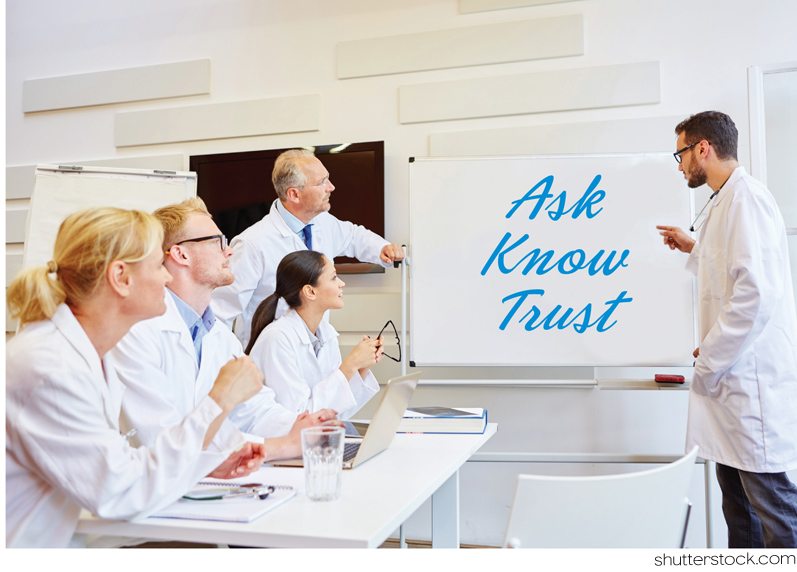
There’s probably no word more ubiquitous in the healthcare industry these days than “trust.” It applies to the relationship between pharma and both doctors and patients. Although most of the industry still operates at a high level of integrity, trust has fallen in recent years. So we have to work harder to address that.
What gets in the way of doctor-manufacturer trust? Lots of things. Among them, skepticism about advertising. Traditional “selling” methods, as differentiated from “conversations.” Difficulty in finding the right information in a streamlined way. And, of course, HCPs are busier than ever. The sheer weight of digital and physical paperwork; staff responsibilities; regulatory requirements; and more, have frustrated the physician’s ability to do the primary work of patient care.
Doctors spend an average of 3.5 hours a day on EHRs and another 2.2 hours using other external digital resources1, cutting into the time they would prefer to spend in exam rooms and in other contact with patients, such as virtual consultations. They also have the impression that they are being “advertised to” rather than having their needs addressed. And then there’s the increased dialogue that has been building between doctors and pharmacists, and the collaboration among multiple doctors for each patient. This is a good sign, but one that makes further demands on the time physicians have available to learn about treatments from manufacturers.
What is Access?
Of course, in the other direction, pharma is trying to figure out what the changing definition of “access” is exactly. ZS Associates (http://bit.ly/2oEixCS) estimates that access to doctors has been cut severely in just a few years, from 65% across the industry in 2012 to just 44% in 2016. But that doesn’t mean doctors don’t want access—they just want it in a new way. Last year, one of our KOLs, Dr. Malissa Wood, Co-director of the Corrigan Women’s Heart Health Program at Massachusetts General Hospital and Assistant Professor of Medicine at Harvard Medical School, put it succinctly: “The pendulum needs to swing in the other direction because (pharma) need us to give them guidance…and we need them to really address the issues that are pressing.”
“The Ask”
Today, communication has to be a two-way street—a dialogue. You have to start by listening to what your customers need—and identify “the ask,” and then provide information in a more personalized way about disease states, efficacy, safety, dosages, insurance coverage, and other important issues. Listening takes many forms: Direct conversation with your key constituents, regular research among your target physicians, and data gathered through interaction with messages across marketing channels. And information doesn’t have to be provided face-to-face, given the many other avenues available for communication. We have to readjust our notion of what it means to have “contact” with a doctor. Fortunately, efforts are afoot in the industry to address the right way to foster this “contact.”
Predictive analytics and modeling is rapidly becoming a powerful tool. Historically, manufacturers have relied on a target list informed by certain key measures such as decile, Rx history, and called upon vs. no-see physicians. This works as a good starting point for targeting marketing messages. But as Rx data is mined more deeply, additional target research becomes available, and interaction data with brand content is analyzed, targeting capabilities become iteratively more accurate. You can begin to more accurately identify early adopters for a launch brand. You can identify experts on the category or on the brand, or even brand influencers. You can begin to identify educational gaps in certain segments, message resonance between segments and even map these learnings back to the HCP level for 1:1 intelligence.
There’s abundant evidence that, in seeking specific details, physicians often reveal even more about where knowledge gaps exist. Fortunately, emerging strategies in analytics have helped identify these areas, so we are getting more sophisticated at offering precise information that doctors may not have known they needed.
“The Know”
Once you’ve identified appropriate needs, offering the right information becomes a combined effort, taking an inventory of approved messaging and available assets, and prioritizing assets that need to be developed. This becomes “The Know”—the ability to provide the right information to the right physician to increase knowledge and improve the care they can offer their patients. As this cycle is repeated, continuously gathering insights on which messages are working for which physician segments; when messaging may need to be refreshed; and which segments should be newly targeted for new initiatives; the “contact” becomes more effective and more helpful to physicians.
Evidence suggests that the industry is getting smarter about how to conduct the conversation—starting with listening. We are discovering the platforms where doctors can easily obtain the information they’ve asked for—or indeed the information they may not have known they needed. This new intelligence provides life sciences companies with a better understanding of the path toward greater trust. As a result, they can refine the formerly blunt marketing instruments that provided too much information to too many customers over too many channels, and concentrate these to create a finely tuned program of communication to the right physicians, at the right time, in the right place.
“The Trust”
Not only does this make efforts much more efficient, it makes them more personal, thus getting closer to that relationship marketing holy grail that all of us seek. Even while we experience a change in the former face-to-face connection that the industry was once accustomed to, we are now able to conduct that conversation in a different way and satisfy the desires of both physicians and manufacturers.
So “the trust” is gained through a straight path from hearing what each doctor wants, to providing that information on a platform where trust has already been established, and engaging in an ongoing conversation that enhances that trust. The path is right in front of us—we just have to follow it.
Resources:
1. Decision Resources Group







